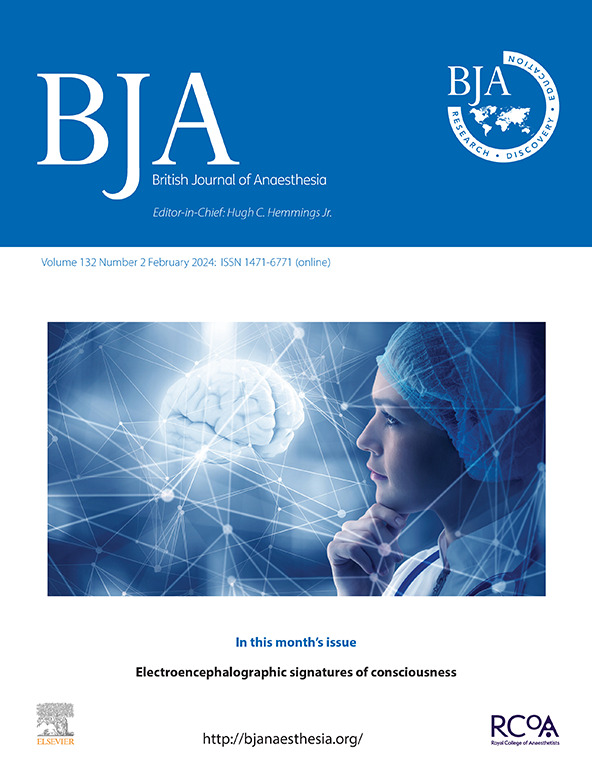Videolaryngoscopy versus direct laryngoscopy for teaching direct laryngoscopy skills: a systematic review and meta-analysis.
IF 9.1
1区 医学
Q1 ANESTHESIOLOGY
引用次数: 0
Abstract
BACKGROUND It is established that videolaryngoscopy improves intubation success rates and views compared with direct laryngoscopy. However, concerns regarding default adoption of videolaryngoscopy include a negative impact on skill acquisition for direct laryngoscopy. This study aimed to assess the utility of Macintosh videolaryngoscopy for teaching direct laryngoscopy. METHODS We systematically searched MEDLINE and Embase databases for relevant randomised controlled trials, crossover, and observational studies. Two authors screened abstracts and full-text manuscripts for inclusion before extracting and cross-checking data. Critical outcomes included first-attempt success, overall success, and time to intubation, with trainee confidence and ease of guidance assessed as secondary outcomes. Meta-analysis was performed using random-effects models. Risk of bias was assessed using the Cochrane RoB-2 tool. RESULTS We identified 21 relevant studies, 10 of which assessed Macintosh videolaryngoscopy for teaching direct laryngoscopy. For first-attempt success, videolaryngoscopy outperformed direct laryngoscopy with a risk ratio (RR) of 1.16 ([95% confidence interval 1.07-1.25]; five studies; I2= 17%). Overall intubation success did not differ significantly between videolaryngoscopy and direct laryngoscopy training (RR 1.05 [0.99-1.12]; seven studies; I2=27%) and neither did time to successful intubation (mean difference -7.4 s [-15.8 s to 0.9 s]; seven studies; I2=73%). All but two studies raised concern for risk of bias in at least one domain. Limitations included small sample sizes and heterogeneous data presentation. Sensitivity analyses favoured videolaryngoscopy. CONCLUSIONS Videolaryngoscopy appears to be an effective tool for teaching direct laryngoscopy. Its role as a preferred teaching tool should be considered. SYSTEMATIC REVIEW PROTOCOL PROSPERO (CRD42023493366).视频喉镜与直接喉镜对直接喉镜技能教学的影响:一项系统回顾和荟萃分析。
背景与直接喉镜相比,视频喉镜可以提高插管成功率和视野。然而,关于默认采用视频喉镜检查的担忧包括对直接喉镜检查技能习得的负面影响。本研究旨在评估麦金塔视频喉镜在直接喉镜教学中的应用。方法系统检索MEDLINE和Embase数据库,检索相关的随机对照试验、交叉试验和观察性研究。两位作者在提取和交叉检查数据之前筛选了摘要和全文手稿。关键结果包括首次尝试成功、总体成功和插管时间,受训者的信心和指导的容易程度被评估为次要结果。采用随机效应模型进行meta分析。使用Cochrane rob2工具评估偏倚风险。结果我们确定了21项相关研究,其中10项评估了Macintosh视频喉镜检查在直接喉镜检查教学中的应用。对于首次尝试的成功,视频喉镜检查优于直接喉镜检查,风险比(RR)为1.16([95%可信区间1.07-1.25];五个研究;I2 = 17%)。总插管成功率在视频喉镜和直接喉镜训练之间无显著差异(RR 1.05 [0.99-1.12];七个研究;I2=27%),到插管成功的时间也没有差异(平均差值为-7.4 s [-15.8 s至0.9 s];七个研究;I2 = 73%)。除了两项研究外,所有研究都对至少一个领域的偏倚风险提出了担忧。限制包括小样本量和异构数据表示。敏感性分析倾向于视频喉镜检查。结论视频喉镜是指导直接喉镜检查的有效工具。应该考虑它作为首选教学工具的作用。系统评价协议prospero (crd42023493366)。
本文章由计算机程序翻译,如有差异,请以英文原文为准。
求助全文
约1分钟内获得全文
求助全文
来源期刊
CiteScore
13.50
自引率
7.10%
发文量
488
审稿时长
27 days
期刊介绍:
The British Journal of Anaesthesia (BJA) is a prestigious publication that covers a wide range of topics in anaesthesia, critical care medicine, pain medicine, and perioperative medicine. It aims to disseminate high-impact original research, spanning fundamental, translational, and clinical sciences, as well as clinical practice, technology, education, and training. Additionally, the journal features review articles, notable case reports, correspondence, and special articles that appeal to a broader audience.
The BJA is proudly associated with The Royal College of Anaesthetists, The College of Anaesthesiologists of Ireland, and The Hong Kong College of Anaesthesiologists. This partnership provides members of these esteemed institutions with access to not only the BJA but also its sister publication, BJA Education. It is essential to note that both journals maintain their editorial independence.
Overall, the BJA offers a diverse and comprehensive platform for anaesthetists, critical care physicians, pain specialists, and perioperative medicine practitioners to contribute and stay updated with the latest advancements in their respective fields.

 求助内容:
求助内容: 应助结果提醒方式:
应助结果提醒方式:


